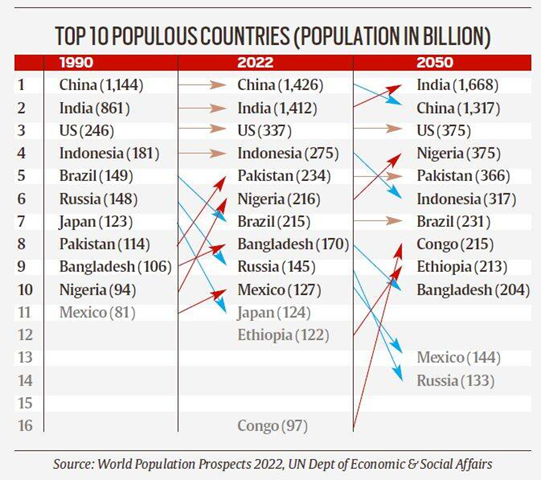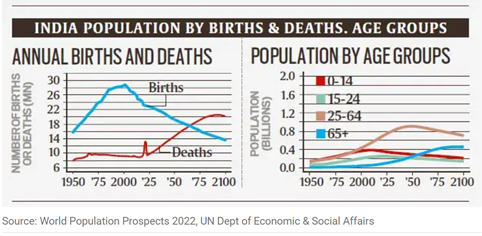

12th July 2022 (7 Topics)
Context
According to World Population Prospects 2022, India is projected to surpass China as the world’s most populous country in 2023.
- It also projected the world’s population to reach 8 billion on November 15, 2022.
About
World Population Prospects:
- It has been published by the Population Division of the UN Department of Economic and Social Affairs in a biennial cycle since 1951.
- Each revision of the WPP provides a historical time series of population indicators starting in 1950.
- It does so by taking into account newly released national data to revise estimates of past trends in fertility, mortality or international migration.
- World Population Prospects 2022 also states that fertility has fallen markedly in recent decades for many countries.
Main takeaways for the global population:
- The global population is projected to reach eight billion November 15, 2022.
- It is growing at its slowest rate since 1950, having fallen under one per cent in 2020.
- The world’s population could grow to around 5 billion in 2030 and 9.7 billion in 2050.
- It is projected to reach a peak of around 4 billion people during the 2080s and to remain at that level until 2100.
- Two-thirds of the global population lives in a country or area where lifetime fertility is below 2.1 births per woman, roughly the level required for zero growth in the long run for a population with low mortality.
- The populations of 61 countries or areas are projected to decrease by one per cent or more between 2022 and 2050, owing to sustained low levels of fertility.
- The share of the global population aged 65 years or above is projected to rise from 10% in 2022 to 16% in 2050.
- The report warns that countries with ageing populations should take steps to adapt public programmes to the growing proportion of older persons, including by improving the sustainability of social security and pension systems and by establishing universal health care and long-term care systems.
- In most countries of sub-Saharan Africa, as well as in parts of Asia and Latin America and the Caribbean, the share of population at working age (between 25 and 64 years) had been increasing thanks to recent reductions in fertility.
- Global life expectancy at birth reached 8 years in 2019, an improvement of almost nine years since 1990.
- As per the report, the COVID-19 pandemic affected all components of population change. Global life expectancy at birth fell to 71 years in 2021.
- Over the next few decades, migration will be the sole driver of population growth in high-income countries.
- For 10 countries, the estimated net outflow of migrants exceeded 1 million over the period from 2010 through 2021.

- For 10 countries, the estimated net outflow of migrants exceeded 1 million over the period from 2010 through 2021.
Key findings on India by the report:
- India is projected to surpass China as the world’s most populous country in 2023.
- India, along with seven will make up over half of the estimated increase in the global population up to 2050.
- The eight countries include:
- The Democratic Republic of the Congo,
- Egypt
- Ethiopia
- India
- Nigeria
- Pakistan
- The Philippines
- Tanzania
- Health experts have called for more investment in healthcare sector in India



